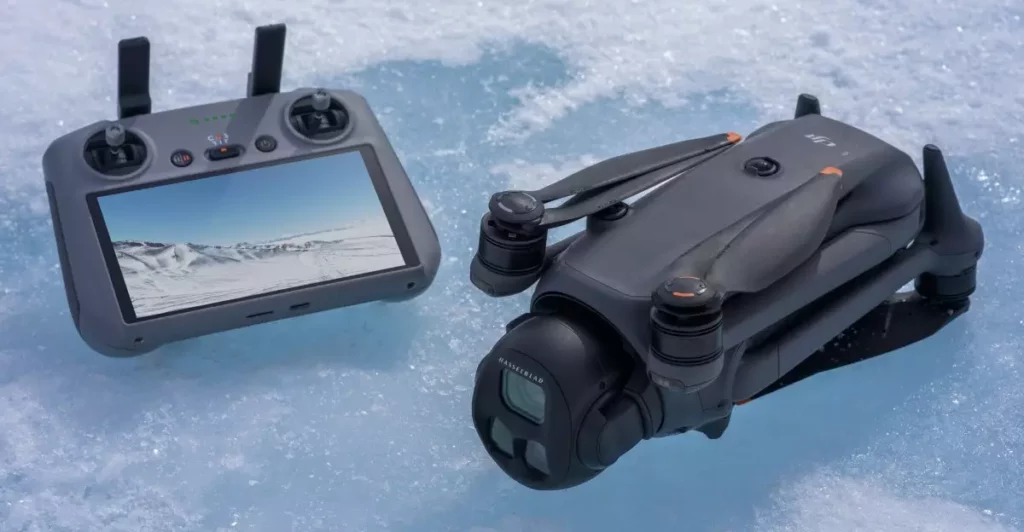The tech community recently buzzed with the launch of the DJI Mavic 4 Pro, which, at a starting price of $2,699, heralds a new era in drones aimed at both amateurs and professionals. While the excitement surrounding its advanced features is palpable, one must critically assess whether the buzz translates into a genuine game-changer in aerial photography. As a self-proclaimed tech enthusiast and center-rightwing liberal, I find it bewildering that while innovation pushes forward, the accessibility for the average consumer remains elusive.
DJI’s decision to initially withhold the Mavic 4 Pro from the U.S. market is particularly interesting. Many enthusiasts were left scratching their heads as strict trade tariffs posed logistical challenges. With Adorama and B&H stepping in to make the drone available, it raises an intriguing question: was this a savvy marketing strategy, or a desperate attempt to meet overwhelming consumer demand? This push-and-pull relationship between manufacturers and retailers speaks volumes about how corporations can adapt to regulatory constraints while still fulfilling consumer desires.
Luxury or Necessity? A Two-Edged Sword
The tiered pricing strategy employed by DJI deserves scrutiny. The base model’s price of $2,699, coupled with bundles reaching upwards of $4,649, positions the Mavic 4 Pro squarely in the luxury domain. What’s commendable is DJI’s clear target towards professional users who demand high-end features; however, the reality is that many aspiring drone pilots, eager to make their first purchase, can feel disillusioned by these inflated prices.
From an economic standpoint, this high-tier pricing could alienate a segment of the market keen to explore aerial photography without frontal sacrifices. It reflects a glaring disconnect between what consumers want and what they can afford. Yes, high-quality features often come with a price tag, but shouldn’t companies like DJI strive for a more versatile approach that includes entry-level models? It’s a missed opportunity to cultivate a budding community of drone enthusiasts who could ultimately elevate the brand over time.
The Role of Retailers: Equal Parts Heroes and Villains
As I explored the offerings at Adorama and B&H, I marveled at the intricate web of consumer behavior and strategic marketing that defined their pre-order and sales tactics. Adorama’s aggressive approach to selling their initial batch of the Mavic 4 Pro saw supply dwindle quickly, raising questions about supply chain management and transparency. Shouldn’t consumers expect their excitement to translate into more reliable availability? Does quick turnover imply strong demand or signify inadequacies in production logistics?
B&H’s decision to not charge until shipping exemplifies trust-building, yet it also left consumers oscillating between eager anticipation and uncertainty. This tactic seems like an attempt to mitigate the fear of making an investment in a product that may not arrive when promised, yet every moment that drags on continues to feed the anxiety and speculation among buyers. It feels as though consumers are caught in a love-hate relationship with these corporations.
A Mysterious Market Shift
One cannot ignore the clouds of ambiguity that appear to surround this entire launch. Did DJI, in a moment of misguided optimism, release only a limited stock in anticipation of hefty demand, or were they compelled to rethink their distribution strategy as retailers pushed for more availability? As we engage with this intrigue, it becomes clear that such scenarios only amplify the complexities of global tech commerce.
The larger implications of the Mavic 4 Pro launch reflect ongoing tensions within an industry characterized by rapid innovation and a simultaneous struggle against regulatory and logistical hurdles. As developments unfold, it becomes evident that the ability to adapt quickly is as crucial as the technology itself. For consumers, this may ultimately dictate their powers of choice and accessibility and, unfortunately, their experience as buyers seeking cutting-edge products.
A Balancing Act for the Future
The emergence of the DJI Mavic 4 Pro serves as a historical nexus for aspiring aerial photographers and seasoned professionals alike. Are consumers willing to navigate potential delays and market drama to embrace this technological leap? The Mavic 4 Pro undoubtedly exhibits capabilities that excite both the imagination and the ambition. Nevertheless, whether it’s truly a game-changer or merely an expensive trinket remains an unsettled question. In a world where accessibility often takes a backseat to profit margins, balancing innovation with inclusivity should remain a paramount goal for any forward-thinking corporation. As I analyze this unfolding saga, it’s clear that keen scrutiny of both products and practices will continue to shape the trajectory of the drone industry.









Leave a Reply